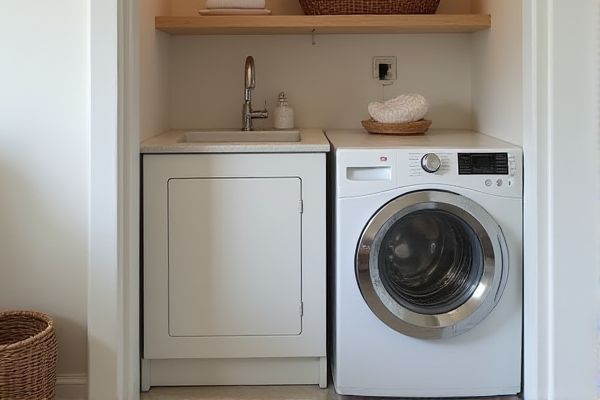
Mini washers offer compact, space-saving solutions ideal for small loads and limited spaces, while combo washer dryers combine washing and drying functions in a single unit, maximizing convenience and efficiency. Discover which option suits your lifestyle and space by reading the rest of the article.
Table of Comparison
| Feature | Mini Washer | Combo Washer Dryer |
|---|---|---|
| Function | Washing only | Washing and drying in one unit |
| Size | Compact, ideal for small spaces | Larger than mini washers but still space-saving |
| Capacity | 2-6 kg | 5-10 kg |
| Drying Method | None; requires separate drying | Built-in condenser or vented drying |
| Energy Efficiency | Generally lower energy use due to smaller load | Moderate; combined functions consume more energy |
| Installation | Simple; portable options available | Requires proper plumbing and ventilation |
| Price Range | Low to mid-range ($100 - $300) | Mid to high-range ($600 - $1200) |
| Best For | Single users, small laundry loads, tight spaces | Small families needing all-in-one solution |
Introduction to Mini Washer and Combo Washer Dryer
Mini washers offer compact, single-function laundry solutions ideal for small spaces and light loads, featuring efficient water and energy use. Combo washer dryers integrate washing and drying in one appliance, optimizing space while providing convenience through multi-cycle programs suitable for various fabric types. Choosing between these options depends on specific household needs, space constraints, and laundry volume preferences.
How Mini Washers Work
Mini washers operate using a compact agitator or impeller system that mimics traditional washing machines but on a smaller scale, optimizing water and detergent use for small loads. These machines utilize specialized cycles designed for delicate fabrics and lightly soiled garments, ensuring efficient cleaning with reduced energy consumption. Their compact size and simplified mechanics make them suitable for limited spaces, providing convenience without sacrificing cleaning performance.
How Combo Washer Dryers Function
Combo washer dryers integrate washing and drying functions within a single appliance, utilizing a single drum and shared water system to save space and improve efficiency. These machines wash clothes with water and detergent, then switch to a drying cycle that uses either condensation or ventilation technology to remove moisture. Your laundry routine is streamlined as the combo washer dryer handles both cleaning and drying without requiring manual transfer between units.
Space Efficiency: Mini Washer vs Combo Washer Dryer
Mini washers offer significant space efficiency due to their compact size, making them ideal for small apartments or limited laundry areas. Combo washer dryers, while slightly larger, combine washing and drying functions in one unit, saving space by eliminating the need for separate appliances. Both options optimize small living spaces, but mini washers prioritize footprint reduction, whereas combo units maximize utility within that footprint.
Washing and Drying Performance Comparison
Mini washers provide efficient washing performance ideal for small loads, but often lack integrated drying capabilities, requiring separate drying units. Combo washer dryers combine both functions in one machine, offering convenience with moderate drying efficiency that may be slower or less thorough than standalone dryers. Users prioritizing space-saving solutions benefit from combo units despite potential compromises in drying speed and capacity compared to dedicated mini washers paired with separate dryers.
Energy and Water Consumption Differences
Mini washers typically consume less water and energy due to their smaller capacity and shorter cycles, making them ideal for individuals or small households aiming to reduce utility bills. Combo washer dryers integrate washing and drying functions in one machine, often using more energy and water during the drying phase, which can increase overall consumption compared to a standalone mini washer. Your choice between these appliances can impact long-term savings and environmental footprint based on your laundry frequency and load size.
Cost Analysis: Mini Washer vs Combo Washer Dryer
Mini washers typically have a lower upfront cost, ranging from $250 to $600, making them an economical choice for small spaces or occasional use. Combo washer dryers combine washing and drying functions in one unit, with prices generally between $600 and $1,200, offering convenience but at a higher initial investment. When considering long-term utility expenses, combo units may consume more energy due to the drying cycle, potentially increasing electricity costs compared to standalone mini washers.
Maintenance and Durability
Mini washers typically require less maintenance due to their simpler design and fewer components, making them easier to clean and service. Combo washer dryers, while space-saving, involve more complex mechanisms that may necessitate regular upkeep to prevent issues such as vent blockages and wear on drying elements. Durability in mini washers often exceeds that of combo units, as the integrated drying function in combos introduces additional strain on internal parts, potentially reducing lifespan.
Best Use Cases for Each Appliance
Mini washers excel in small living spaces, such as apartments or dorm rooms, where washing large loads is unnecessary and portability is key. Combo washer dryers are ideal for those with limited space who need the convenience of washing and drying in one appliance, making them perfect for efficiency in tiny homes or condos. Your choice depends on whether you prioritize compact washing solutions or integrated laundry functions in a single machine.
Choosing the Right Washer for Your Home
Mini washers excel in compact spaces, offering efficient washing cycles ideal for small loads and quick turnarounds. Combo washer dryers save space by combining washing and drying functions in one unit, perfect for apartments lacking separate laundry areas. Selecting the right washer depends on your available space, laundry volume, and drying needs, ensuring optimal convenience and performance.
 homyna.com
homyna.com